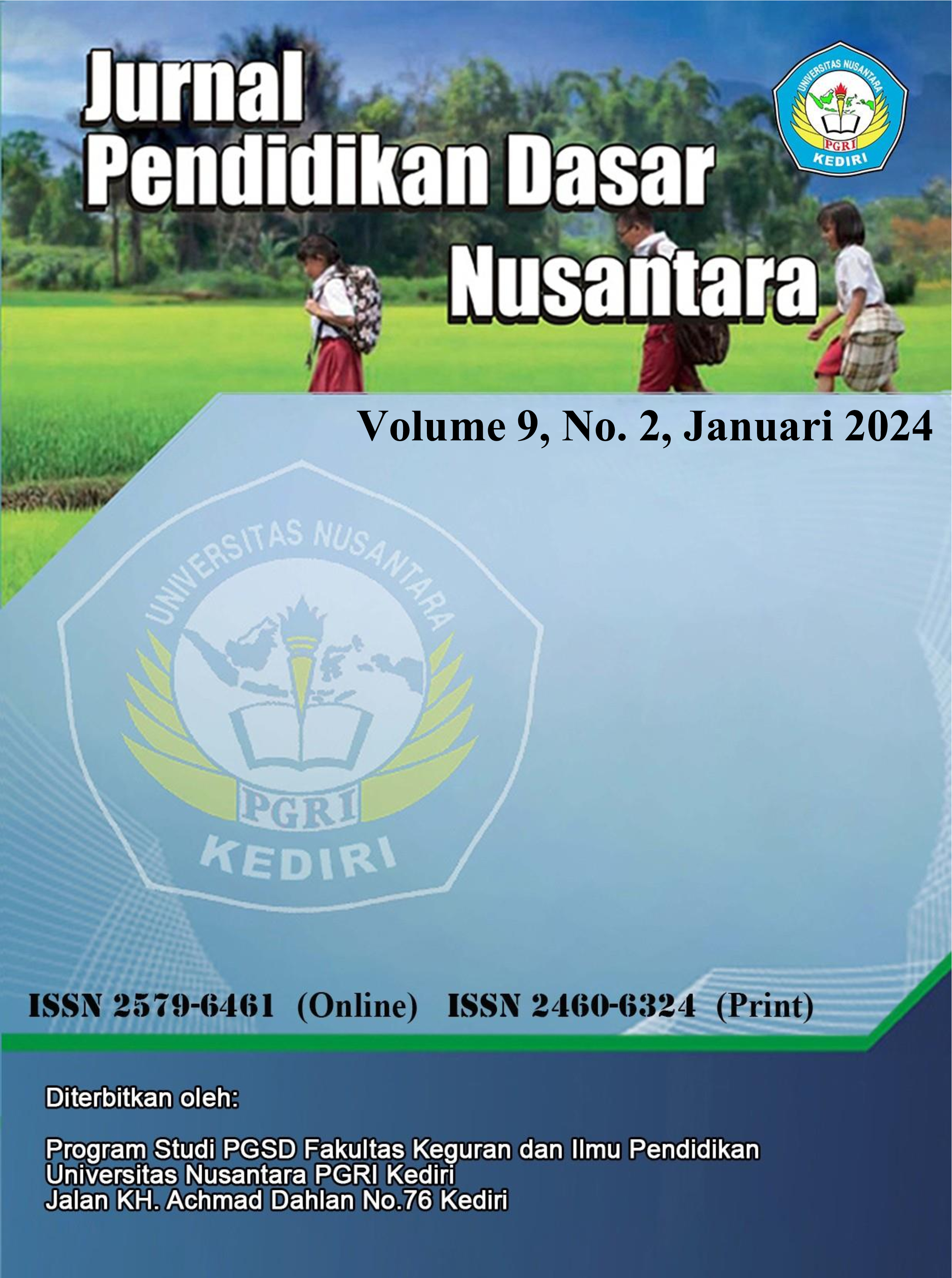Improving mathematics learning outcomes on subtraction material using canva-based learning media for grade 1 elementary school students
DOI:
https://doi.org/10.29407/jpdn.v9i2.20880Keywords:
matematika, canva, hasil belajarAbstract
The aim of this research is to improve the learning outcomes of grade 1 students in mathematics subtraction material at SDN 1 Kepatihan Tulungagung which consists of 21 students. The research method uses classroom action research which uses the spiral model emphasized by David Hopkins, where there are four stages, namely planning, action, observation and reflection (Hopkins, 2011: 91). The data collection techniques used were, 1) Observation, 2) Test, 3) Documentation, 4) Interview, then quantitative descriptive analysis was carried out from the data obtained with the following results: 1) At the pre-cycle stage the class average value was 73, 8 with a classical completion percentage of 38.09%. 2) Then, in the first cycle stage, the average class score increased to 81.47 with a classical completeness percentage of 42.85%. 3) Furthermore, in the second cycle stage the class average increased to 91.8 with a classical completeness percentage of 85.71%. Based on the results of the research conducted, it can be concluded that the use of Canva-based learning media can improve mathematics learning outcomes in subtraction material for grade 1 students at SDN 1 Kepatihan Tulungagung.
Downloads
References
Aka, K. A., & Sahari, S. (2017). Pengembangan Bahan Ajar Multimedia Interaktif Pada Pembelajaran PKN Kelas V Sekolah Dasar Berorientasi Teknik Klarifikasi Nilai. Jurnal Pendidikan Dasar Nusantara, 3(1), 70-96.
Anjarwati, D., Winarno, A., & Churiyah, M. (2016). Improving learning outcomes by developing instructional media-based Adobe Flash Professional CS 5.5 on principles of business subject. IOSR Journal of Research & Method in Education, 6(5), 1–6. https://doi.org/10.9790/7388-0605010106
Hakim, A. R., & Windayana, H. (2016). Pengaruh penggunaan multimedia interaktif dalam pembelajaran matematika untuk meningkatkan hasil belajar siswa SD. EduHumaniora| Jurnal Pendidikan Dasar Kampus Cibiru, 4(2).
Handarini, O. I., & Wulandari, S. S. (2020). Pembelajaran Daring sebagai Upaya Study From Home (SFH). Jurnal Pendidikan Administrasi Perkantoran (JPAP), 8(3), 465–503. https://journal.unesa.ac.id/index.php/jpap.
Hidayat, D. R., Rohaya, A., Nadine, F., & Ramadhan, H. (2020). Kemandirian belajar peserta didik dalam pembelajaran daring pada masa pandemi COVID-19. Perspektif Ilmu Pendidikan, 34(2), 147-154.
Hopkins, D. (2011). Panduan Guru Penelitian Tindakan Kelas. Yogyakarta: Pustaka Pelajar.
Hutauruk, P., & Simbolon, R. (2018). Meningkatkan Hasil Belajar Siswa dengan Alat Peraga pada Mata Pelajaran IPA Kelas IV SDN Nomor 14 Simbolon Purba. SEJ (School Education Journal), 8(2), 121-129.
Lin, C.-S., & Wu, R. Y.-W. (2016). Effects of web-based creative thinking teaching on students’ creativity and learning outcome. EURASIA Journal of Mathematics, Science & Technology Education, 12(6), 1675–1684. https://doi.org/10.12973/eurasia.2016.1558a
Mukmin, B. A.. 2016. Pengembangan Buku Ajar Ipa Berbasis Problem Solving Siswa Kelas V SD. Jurnal Pendidikan dan Pembelajaran Anak Sekolah Dasar, 1(02).
Oyedele, V., Rwambiwa, J., & Mamvuto, A. (2013). Using educational media and technology in teaching and learning processes: A case of trainee teachers at Africa University. Academic Research International, 4(1). Retrieved from http://www.savap.org.pk/journals/ARInt./Vol.4(1)/2013(4.1-30).pdf
Parahita, I. N., Santiyadnya, N., & Sutaya, I. W. (2019). Learning Community untuk Meningkatkan Hasil Belajar Perawatan PC. Jurnal Pendidikan Teknik Elektro Undiksha, 8(3), 118–127
Pelangi, G. (2020). Pemanfaatan Aplikasi Canva Sebagai Media Pembelajaran Bahasa Dan Sastra indonesia Jenjang SMA/MA. Jurnal Sasindo Unpam.
Purwono, J., Yutmini, S., & Anitah, S. (2014). Penggunaan media audio-visual pada mata pelajaran Ilmu Pengetahuan Alam di Sekolah Menengah Pertama Negeri 1. Jurnal Teknologi Pendidikan Dan Pembelajaran, 2(2), 18. Retrieved from https://www.jurnal.fkip.uns.ac.id/index.php/tp/article/viewFile/3659/2560
Rahmatullah, R., Inanna, I., & Ampa, A. T. (2020). Media pembelajaran audio visual berbasis aplikasi canva. Jurnal Pendidikan Ekonomi Undiksha, 12(2), 317-327.
Rahmatullah, R., Inanna, I., & Nurdiana, N. (2019). "Ethnopedagogi dalam pembelajaran ekonomi". Seminar Nasional Lembaga Penelitian UNM, 284–288.
Ramli, A., Rahmatullah, R., Inanna, I., & Dangnga, T. (2018). "Peran Media Dalam Meningkatkan Efektivitas Belajar". Lembaga Pengabdian Kepada Masyarakat Universitas Negeri Makassar, 5–7.
Sobarningsih, N., Sugilar, H., & Nurdiansyah, R. (2019). Analisis implementasi standar proses pembelajaran guru matematika. Prima: Jurnal Pendidikan Matematika, 3(1), 67-84.
Supriyadi, & Wiliyanto, D. A. (2021). Analisis Kebutuhan dan Masalah Pembelajaran Jarak Jauh pada Anak Berkebutuhan Khusus di Masa Pandemi Covid-19. Jurnal Basicedu, 5(3), 1667–1672.
Tanjung, R. E., & Faiza, D. (2019). Canva sebagai media pembelajaran pada mata pelajaran dasar listrik dan elektronika. Voteteknika (Vocational Teknik Elektronika Dan Informatika), 7(2), 79-85.
Widiyawati, Y. (2017). Pemanfaatan media pembelajaran IPA bagi peserta didik visual impairment di SLB. JIPVA (Jurnal Pendidikan IPA Veteran), 1(1), 9–23. Retrieved from http://e-journal.ivet.ac.id/index.php/jipva/article/view/510
Yanti, E. R. W., & Abdullah, M. H. (2017). Penerapan Model Pembelajaran Time Token Arends untuk Meningkatkan Hasil Belajar Siswa Kelas IV SDN Lakarsantri I/472 Surabaya. Jurnal Penelitian Pendidikan Guru Sekolah Dasar, 5(3), 1010–1020.
Yulianti, Y. (2019). "Contextual Teaching Learning Dalam Pembelajaran Ekonomi". Pinisi Business Administration Review, 1(2).
Downloads
Published
Issue
Section
License
Authors who publish with this journal agree to the following terms:
- Copyright on any article is retained by the author(s).
- The author grants the journal, the right of first publication with the work simultaneously licensed under a Creative Commons Attribution License that allows others to share the work with an acknowledgment of the work’s authorship and initial publication in this journal.
- Authors are able to enter into separate, additional contractual arrangements for the non-exclusive distribution of the journal’s published version of the work (e.g., post it to an institutional repository or publish it in a book), with an acknowledgment of its initial publication in this journal.
- Authors are permitted and encouraged to post their work online (e.g., in institutional repositories or on their website) prior to and during the submission process, as it can lead to productive exchanges, as well as earlier and greater citation of published work.
- The article and any associated published material is distributed under the Creative Commons Attribution-ShareAlike 4.0 International License
































